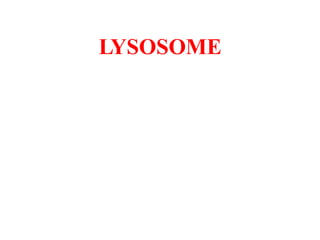
lysosome_ppt_msc.pptx_cell biology_cell organelles
- 1. LYSOSOME
- 2. LYSOSOMES Lysosomes are spherical organelle that contain enzymes acid hydrolases. They break up food so it is easier to digest. They are found in animal cells, while in yeast and plants the same roles are performed by Lytic vacuoles. Lysosomes were discovered by the Belgium cytologist • Christian de Duve in 1955, and named as "suicide bags" or "suicide sacs“. 2
- 4. ORIGIN – lysosomes may originated from the endoplasmic reticulum and Golgi membranes from the process of budding off. Novikoff ( 1960 ) found that acid phosphatase one of the characteristic enzymes of the lysosome.
- 5. Prokaryotes do not have lysosomes but some hydrolases have been located outside the cell. Lysosomes found in higher animal. Fig :1 - Lysosome 3
- 6. 4 Lysosomes are globular and range in diameter from 0.2 to 0.8 microns. Under the electron microscope lysosomes appear dense and finely granular. Lysosome is essentially a sphere of lipoprotein membrane containing enzymes. The membrane insulates the enzyme from the rest of the cell. If the enzymes are released they can digest the cell and hence lysosomes are sometime called ‘’ suicide bags.’’ Lysosomal membrane lipoprotein membrane. The membrane is impermeable to substrates of the enzymes contained in the lysosome. Certain substances called labializer caused instability of the lysosomal membrane, leading to release of enzyme from the lysosome.
- 7. Other substance called stabilizers have a stabilizing action on the membrane. Labilizers E.g; - vitamin A , vitamin B, vitamin K, vitamin E. Stabilizers E.g. – cholesterol, cortisone, cortisol. Molecular weight and molecular structure play an important part in the permeability of the lysosomal membrane. Compound having a molecular weight higher than 200 do not diffuse through the membrane. 5
- 8. Fig:2- Structure of lysosome 6
- 9. Lysosomes contain these type of enzymes 1. Nucleases – which include ribonuclease and deoxyribonuclease , break down polynucleotides into nitrogen bases, phosphates and pentose sugars. 2. Phosphatases – acid phosphate, breakdown phoshate esters to monophosphates. 3. Lipases – lipids, breakdown them into fragments. 4. Proteases - protein, breakdown into their constituent amino acids. 5. Glycosidases – β- galactosidase, β – glucuronidase, ά- mannosidase, breakdown into polysaccharides to monosaccharides. 6. Sulphatases – act on sulphate esters, breaking down into fragments. 7
- 10. 9 The lysosomes shows polymorphism in different cell types and even within the single cell. Previously, there are two types of lysosomes - primary and secondary lysosomes. The latter are of three type - phagosomes, residual bodies, autophagic vacuoles. 1. Primary lysosome is formed from endoplasmic reticulum and Golgi complex. The enzymes of the primary lysosome are synthesized by ribosomes, it can secrete its enzyme outside the cell or store them. 2. Phagosome is formed by phagocytosis and pinocytosis of foreign material. The phagosome associates with a primary lysosome and undergoes fusion to form secondary lysosome.
- 11. 3. Residual body is the final particle containing indigestible material. It is formed when digestion is incomplete. 4. The autophagic vacuole or autophagosome is a lysosome containing some parts of cell in the process digestion 10
- 12. The lysosome is essentially a bag containing digestive enzymes. The enzymes may be released within the cell itself or out side the cell. LYSOSOMES SERVES SEVERAL FUNCTION A. Extracellular digestion B. Intracellular digestion C. Hormone secretion D. Fertilization E. Autolysis F. Chromosomal breaks 12
- 13. A. Extracellular digestion Digestion of extracellular matrix is a two way process involving both extracellular and intracellular digestion. • The primary lysosome secrete hydrolases into the exctracellular matrix by exocytosis, resulting in partial degradation of the matrix. The incomplete products of digestion are absorbed into the cell by endocytosis. Digestion is then complete in the secondary lysosomes. • Extracellular digestion takes place during bone erosion process. 13
- 14. B. Intracellular digestion – Intracellular digestion may involve autophagy and heterophagy. Autophagy – It is intracellular digestion in which enzymes produced by the cell breakdown molecules and pieces of cytoplasmic material from the cell itself. Heterophagy – It is the intake of exogenous material into the cell and the subsequent breakdown of this material by enzymes by the process of endocytosis. Heterophagy are two types namely - Phagocytosis and Pinocytosis. 14
- 15. C. Hormone secretion - There are evidence that lysosomal hydrolases are involved in the secretory activity of some cells. They function in modifying the products synthesized by the cell before secretion and also in the regulation of secretion. 15
- 16. D. Fertilization During fertilization process, acrosome (giant lysosome) of sperm head ruptures and releases enzymes on the surface of the egg. These enzymes digest the egg membrane and provide way for the entry of sperm nucleus into the egg. 16
- 17. E. Autolysis Autolysis refers to the digestion of own cells by the lysosomes. 18
- 18. F. Chromosomal breaks - Lysosome contain the enzyme deoxyribonuclease (DNase) which attacks DNA and causes chromosomal breaks and rearrangement. Thus release of hydrolases from lysosomes can result in structural abnormalities in chromosomes. That can leads to cause disease like cancer etc. 19